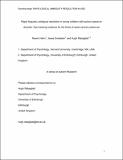| dc.contributor.author | Hahn, Noemi | |
| dc.contributor.author | Snedeker, Jesse | |
| dc.contributor.author | Rabagliati, Hugh | |
| dc.date.accessioned | 2017-04-07T17:03:49Z | |
| dc.date.issued | 2015 | |
| dc.identifier | Quick submit: 2017-03-09T10:29:03-0500 | |
| dc.identifier.citation | Hahn, Noemi, Jesse Snedeker, and Hugh Rabagliati. 2015. “Rapid Linguistic Ambiguity Resolution in Young Children with Autism Spectrum Disorder: Eye Tracking Evidence for the Limits of Weak Central Coherence.” Autism Research 8 (6) (March 28): 717–726. doi:10.1002/aur.1487. | en_US |
| dc.identifier.issn | 1939-3792 | en_US |
| dc.identifier.uri | http://nrs.harvard.edu/urn-3:HUL.InstRepos:32094209 | |
| dc.description.abstract | Individuals with autism spectrum disorders have often been reported to have difficulty integrating information into its broader context, which has motivated the Weak Central Coherence theory of ASD. In the linguistic domain, evidence for this difficulty comes from reports of impaired use of linguistic context to resolve ambiguous words. However, recent work has suggested that impaired use of linguistic context may not be characteristic of ASD, and is instead better explained by co-occurring language impairments. Here we provide a strong test of these claims, using the visual world eye tracking paradigm to examine the online mechanisms by which children with autism resolve linguistic ambiguity. To address concerns about both language impairments and compensatory strategies, we used a sample whose verbal skills were strong and whose average age (7;6) was lower than previous work on lexical ambiguity resolution in ASD. Participants (40 with autism and 40 controls) heard sentences with ambiguous words in contexts that either strongly supported one reading or were consistent with both (John fed/saw the bat). We measured activation of the unintended meaning through implicit semantic priming of an associate (looks to a depicted baseball glove). Contrary to the predictions of weak central coherence, children with ASD, like controls, quickly used context to resolve ambiguity, selecting appropriate meanings within a second. We discuss how these results constrain the generality of weak central coherence. | en_US |
| dc.description.sponsorship | Linguistics | en_US |
| dc.description.sponsorship | Psychology | en_US |
| dc.language.iso | en_US | en_US |
| dc.publisher | Wiley-Blackwell | en_US |
| dc.relation.isversionof | 10.1002/aur.1487 | en_US |
| dash.license | OAP | |
| dc.title | Rapid Linguistic Ambiguity Resolution in Young Children with Autism Spectrum Disorder: Eye Tracking Evidence for the Limits of Weak Central Coherence | en_US |
| dc.type | Journal Article | en_US |
| dc.date.updated | 2017-03-09T15:29:01Z | |
| dc.description.version | Accepted Manuscript | en_US |
| dc.relation.journal | Autism Research | en_US |
| dash.depositing.author | Snedeker, Jesse | |
| dc.date.available | 2015 | |
| dc.date.available | 2017-04-07T17:03:49Z | |
| dc.identifier.doi | 10.1002/aur.1487 | * |
| dash.contributor.affiliated | Snedeker, Jesse | |


